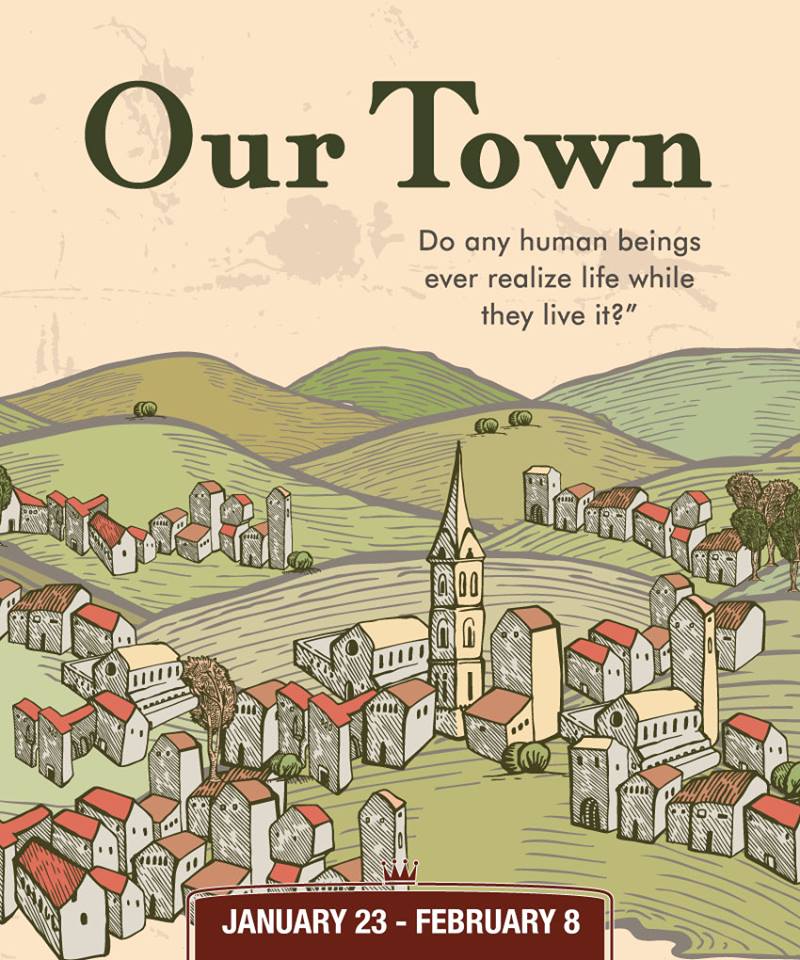SALT LAKE CITY — I had the privilege of attending the Grand Theatre’s production of Our Town on the 75th anniversary of its first performance on Jan 22, 1938, at the McCarter Theater in Princeton, New Jersey. This Pulitzer Prize winning drama by Thornton Wilder remains a classic in American theater and is frequently revived and performed at high schools, colleges, and professional theaters. It is set in three acts and takes place in Grover’s Corners, New Hampshire, a fictional small town where everyone knows everyone. It follows the lives of two families, the Gibbs and the Webbs, and spans several decades of life in Grover’s Corners.

Wilder was largely dissatisfied with the theater of his time, and wrote the script in a metatheatrical style where the narrator is completely aware of the audience and includes them and addresses them throughout the production, frequently commenting on the action and delivering monologues and asides directly to the audience. Additionally, Wilder created the script so that props and set pieces were very minimal, utilizing pantomime and detailed descriptions by the narrator to create the setting and also requiring the audience to actively participate through their imaginations (drawing upon personal life experiences and memories) to create Grover’s Corners. The story deals with humanity, focusing on the struggles, tragedies, and accomplishments in life—from graduating high school, to the wedding of Emily and George, George getting his first job, and Emily’s death during the birth of their first child. Wilder links afterlife and earth-life together, with a message of focusing on what is important in life—the relationships we develop, the knowledge we attain, and the experiences we have.
Director Mark Fossen successfully amounted a talented cast and brought life to this American classic while maintaining the integrity the piece was written in. His focus on the simplicity of the story placed complete focus on the characters and the messages the playwright intended. Act One started off a bit slow, but the actors found their stride in the second and third acts. Robert Scott Smith as the Stage Manager (the play’s narrator) stayed connected to the audience throughout the show, delivering his lines with earnest sincerity and in a conversational style. Julie Silvestro Waite (as Mrs. Gibbs) and Daniel Beecher (as Dr. Gibbs) brought life to their characters teaching moral lessons to their son George as he grew to be a man. The scene where Dr. Gibbs reminds George about his chores, lovingly chastising him for his mother doing George’s chores is a memorable scene, emphasizing Dr. Gibbs’s role in the story. Betsy West (as Mrs. Webb) and David Hanson (as Mr. Webb) also gave strong performances as Emily’s parents. West’s performance was most emotional in the wedding scene and at Emily’s funeral. Hanson provided some great comedic moments, such as the scene in Act Two at the morning of Emily and George’s wedding where Mrs. Webb tells him to give George some advice while she tends to Emily. The awkward silence between George and Mr. Webb was believable and comical as men truly struggle to share their feelings one with another. (Not much has changed their over the past century.)
Cody V. Thompson (as George Gibbs) took a little longer for me to get into his character, as this was not standard casting as the typical “boy next door,” and I didn’t fully believe him in this role. But by the end of the show he had won me over, and I felt the quiet sincerity in his grieving at his young wife’s graveside. Haeleigh Royall (as Emily Webb) provided a strong performance in this role over-all; I would have liked to see a greater degree of vulnerability in the second and third acts, particularly at the wedding, as her emotional state was a bit subdued in this scene. The ensemble supported the principals well by bringing a sense of community to the production, yet never upstaging. Each supporting character contributed to the scene at just the right level.
Several elements also contributed to the success of the production. Spencer Brown’s lighting design set the mood of each scene and helped focus attention to the key moments of the show, such as in the funeral. Halee Rasmussen’s scenic design complemented the style of the show very well and provided dimension and shape to many of the scenes. I was less satisfied with Amanda Reiser’s costume design. I found many of the costumes distracting and could not grasp a clear concept or time period. This muddied the other strong elements of the production.
The Grand delivered a fine production of this classic piece of American theatre. The dated writing style requires an acute attention span, as contemporary audiences are not as accustomed to lengthy expositions and the role of a narrator in describing events in great detail. Once a viewer buys into this convention and style, they will become engrossed in Wilder’s world, and will find the topics and events in the story to be timeless and easy to relate to.
[box type=”shadow”]Our Town plays every Thursday, Friday, and Saturday at 7:30 PM through February 8, with additional performances on January 29 at 7:30 PM and February 1 at 2 PM at the Grand Theatre (1575 S. State Street, Salt Lake City). Tickets are $10-$24. For more information, visit the-grand.org.[/box]
